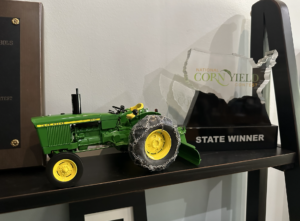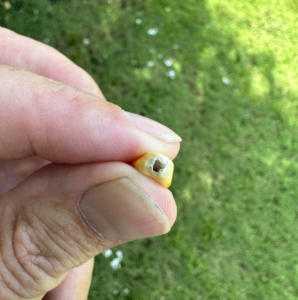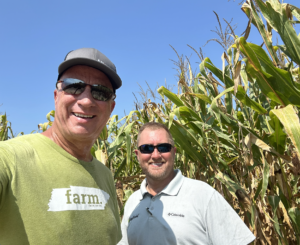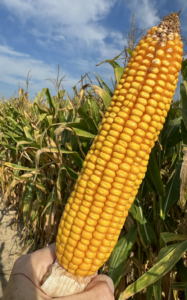We all do it. We track time by referencing memorable items that we or our family once possessed. “Back when he drove that blue Silverado”, or “when she had that yellow Labrador” are examples of how we recall events that shaped our lives. For farmers, those points in time are often defined by a tractor.
Last week, while roaming the Iowa State Fair, I came upon a vendor selling toy tractors. My heart raced when I noticed a model John Deere 2020 utility tractor. Instantly, I was teleported back to my childhood. Back in the day, the 2020 was our chore horse. Equipped with a loader bucket, I spent countless hours riding on its fender (okay, we weren’t exactly a shining example of proper farm safety back in those days) as dad used it to rake hay, spread gravel, load manure, pull hay racks, mow roadsides, and perform countless other jobs on the farm. On the opposite fender, dad mounted a radio (the AM kind) so we could listen to Cardinals baseball and catch the grain market report. Some of the best times of my childhood were spent aboard the 2020. The moment my foot could almost touch the clutch, that was good enough. I drove it to do all the same chores dad did. A trip across the alfalfa field was anything but smooth sailing, but to me those bumps were Heaven sent. During my high school and college years, I used the 2020 to build fences throughout our pasture, mounting a post hole digger to set wood and hedge posts, using the bucket to drive in metal posts, and placing a bar across the 3-point hitch to unroll barbed wire. Once I snapped out of my trip down memory lane, I told the vendor that I want that 2020. She looked at my face, handed me the tractor, smiled, and told me she had a feeling that I was going to enjoy this. I said I already have.
A glass ceiling was shattered last week when Georgia farmer Alex Harrell set a new world soybean yield record of 206 bushels per acre in a 2.5-acre plot. Harrell becomes the first soybean grower to officially eclipse the 200 bu/A milestone. In most areas, 206 is considered an excellent corn yield. Harrell bested the previous mark of 190 bu/A set by fellow Georgian Randy Dowdy in 2019. In 2010, Missouri farmer Kip Cullers helped lead a soybean revolution with a then mind-blowing yield of 160 bu/A. This helped usher in a new way to look at growing the legume, evolving from a secondary crop to an intensely managed headliner. In 2015, Jerry Stoller and his researchers grew 214 bu/A soybeans in a small plot in south Texas. Although that yield was not officially verified, nor did it meet the requirements for an official record, it further showed what’s possible. Such milestones are important benchmarks to help move the industry forward and foster innovation.
Harrell utilized regen ag and soil health practices to reach his landmark yield. This included applying humic acids and fulvic acids at planting. World dryland corn yield record holder Russell Hedrick has also been reported to use humic products. These record-setting accomplishments speak to the validity of using humic substances in row crops. Like many high-yield growers in the South, Harrell also uses chicken manure. There’s something about the organic content of chicken litter that makes plants thrive. He also used a cover crop mix of oats, rye, triticale and radish and irrigated with center pivots.
My corn reached physiological maturity last week. This is commonly referred to as the black layer stage. If you scrape the tip of a kernel with your thumb nail, you’ll reveal the black layer. It’s the natural progression of the crop; a layer of compressed cells forms at the tip of the kernel which blocks the transport of water and nutrients to and from the kernel. This essentially means the crop is made and the management of crop growth is complete. There is nothing you can do to influence kernel size, weight or yield. At this point, the crop is not threatened by frost damage (my field is currently 70 degrees away from that being an issue!), so reaching black layer is a welcomed sight, especially in the upper Midwest. With corn, physiological maturity does not necessarily mean harvest maturity (if the corn is being commercially sold for grain). The moisture content in my corn is still about 30%. Corn is sold to grain elevators at 15% moisture. Elevators will charge farmers drying costs for corn delivered above 15%. In many areas of the South, some grain elevators won’t even accept corn much above 16%. We’ll need to wait for the kernels to dry in the field before harvesting. Depending on the weather, this process often takes anywhere from 2-4 weeks. With the extreme heat we’re experiencing, I suspect it will be on the shorter side. When I farmed in Illinois, there were some falls when the kernels never dried down to 15%.
Over the weekend, my friend Adam Rawls, District Manager for the AgriGold seed company, visited me. He wanted to check out my corn. The first thing he noticed was the size and shape of the kernels. Adam referred to them as boulders. Their shape is bulky and block-like, compared to the traditional curved diamond shape. Will this make a bigger yield? Time will tell. But they sure do feel heavy. Check out the dimples – or lack of – atop the kernels on this ear of corn I pulled from my field (photo attached below). The dimples are called denting, which is a natural progression of the kernels. Many corn aficionados believe the shallower the dents, the better, as it means more dry matter in the kernels. Adam couldn’t believe the number of ears that had virtually no dimples. Genetics plays a role, but nutrition and plant health are key.
Related Posts

Unique Water Towers That You Should See
By Jael Batty From globes to lighthouses, historical and refurbished water towers around the world are eye-catching landmarks.

This Week in Ag #37
One of the greatest inventions in history is the combine. The concept of threshing and separating grain in one operation revolutionized our food system, as well as redefined our labor force. Consider that in the mid-1800s, 90% of the US workforce was involved in some aspect of farming. Now it’s under 2%. To think my grandfather harvested corn by hand and threw the ears in a wagon! He used the pull-behind model in the 1940s to harvest small grains (that’s him, Fred Nichols, combining oats on our family farm). My mother still talks about dad wearing a Jesse James style mask while operating their first self-propelled combine without a cab.

Micronutrients Are the Key to Better Yields
Micronutrients play a critical role in plant vigor, yield, and harvest quality. Yet, they are often overlooked when growers develop their nutrient programs. In this article, we provide an overview of what micronutrients are, the roles they play, how availability is affected by soil and other conditions, how to recognize deficiencies, and the important steps to take when developing a micronutrient plan for your crops.





